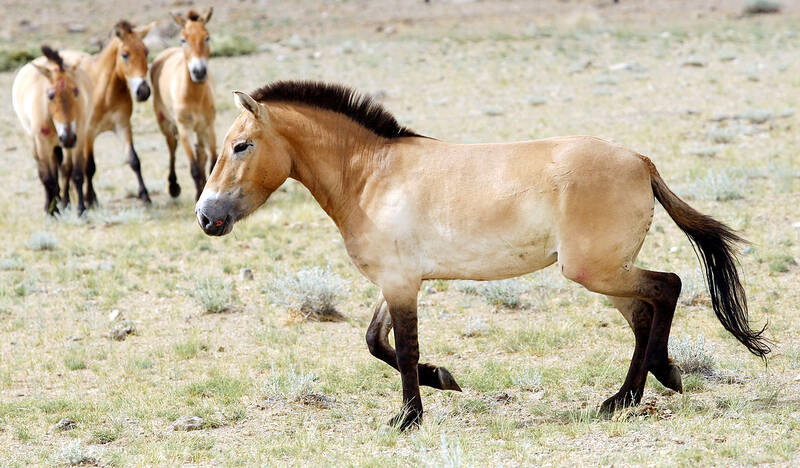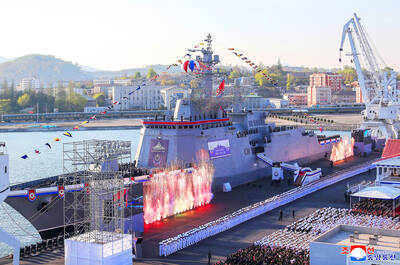The advent of horse-based transportation represented one of the seminal moments for humankind, connecting ancient peoples by enabling them to move quickly over long distances for the first time, while also transforming how wars were waged.
Yet the timing of equine domestication and the subsequent broad use of horse power has been a matter of contention.
An analysis of genome data from 475 ancient horses and 77 modern ones is providing clarity. It found that domestication actually occurred twice — the first time being a dead end — and traced the rise of horse-based mobility to about 2200 BC in Eurasia, centuries later than previously thought.

Photo: AP
“Animal domestication, in general, changed human history, but no other animal was a king-maker as the horse was,” said Pablo Librado, a principal investigator at the Institute of Evolutionary Biology (IBE) in Barcelona, lead author of the study published this week in the journal Nature.
“Think of Genghis Khan, with an empire stretching from the Sea of Japan to the doors of Europe. The world as we know it today has been shaped by horses. Think in agriculture, how important horses were as working animals. Think in New York or Washington 200 years ago, with carriages pulled by horses in the streets,” Librado said.
The genomic evidence showed that horses were first domesticated in Central Asia — northern Kazakhstan to be precise — about 5,500 years ago by people from what is called the Botai culture.
However, this domestication was based on obtaining meat and milk, not movement, and did not spread. The feral Przewalski’s horses of Mongolia descended from those Botai horses.
The domestication of a second equine bloodline began about 4,700 years ago in the western Russian steppes, trotting along for a period of centuries before horse-based mobility suddenly galloped across Eurasia about 4,200 years ago, the study showed.
All modern domestic horses have their origins in this event.
The genomic evidence revealed a shift in breeding practices at that time to satisfy the demand for horses. People doubled horse production capacity by halving the time between generations from eight years to four, said study coauthor Ludovic Orlando, a molecular archeologist at the Center for Anthropobiology and Genomics of Toulouse in France.
“We detect close-kin mating only from that time, and not in the deeper past. This is a practice that wild or domestic horses tend to avoid unless breeders force them to mate with their relatives, to maintain and select for certain valued traits such as increased docility,” Librado said.
“Once horses were spread across Eurasia, and the pressure to further expand them in space and numbers diminished, the horse generation time returned to normal values. The generation times were only reduced again in the last 200 years following industrial breeding — the emergence of new horse breed types tailored to specific tasks,” Librado added.
“We believe that a key element in the early dispersion of horses was the invention of spoke-wheeled chariots, which in contrast to heavier wagons could be pulled by horses and not by cattle for the first time in human history,” Librado said.
There were massive human migrations in Eurasia at around 3000 BC that spread Indo-European languages. Horse-based mobility previously was believed to have played a central role.
“It was thought that human steppe migrations about 5,000 years ago took place on horseback. Our work shows that at that time the horse did not move across the steppe. Hence, while people moved, horses did not,” Orlando said.

Archeologists in Peru on Thursday said they found the 5,000-year-old remains of a noblewoman at the sacred city of Caral, revealing the important role played by women in the oldest center of civilization in the Americas. “What has been discovered corresponds to a woman who apparently had elevated status, an elite woman,” archeologist David Palomino said. The mummy was found in Aspero, a sacred site within the city of Caral that was a garbage dump for more than 30 years until becoming an archeological site in the 1990s. Palomino said the carefully preserved remains, dating to 3,000BC, contained skin, part of the

TRUMP EFFECT: The win capped one of the most dramatic turnarounds in Canadian political history after the Conservatives had led the Liberals by more than 20 points Canadian Prime Minister Mark Carney yesterday pledged to win US President Donald Trump’s trade war after winning Canada’s election and leading his Liberal Party to another term in power. Following a campaign dominated by Trump’s tariffs and annexation threats, Carney promised to chart “a new path forward” in a world “fundamentally changed” by a US that is newly hostile to free trade. “We are over the shock of the American betrayal, but we should never forget the lessons,” said Carney, who led the central banks of Canada and the UK before entering politics earlier this year. “We will win this trade war and

‘BODIES EVERYWHERE’: The incident occurred at a Filipino festival celebrating an anti-colonial leader, with the driver described as a ‘lone suspect’ known to police Canadian police arrested a man on Saturday after a car plowed into a street party in the western Canadian city of Vancouver, killing a number of people. Authorities said the incident happened shortly after 8pm in Vancouver’s Sunset on Fraser neighborhood as members of the Filipino community gathered to celebrate Lapu Lapu Day. The festival, which commemorates a Filipino anti-colonial leader from the 16th century, falls this year on the weekend before Canada’s election. A 30-year-old local man was arrested at the scene, Vancouver police wrote on X. The driver was a “lone suspect” known to police, a police spokesperson told journalists at the

North Korean leader Kim Jong-un has unveiled a new naval destroyer, claiming it as a significant advancement toward his goal of expanding the operational range and preemptive strike capabilities of his nuclear-armed military, state media said yesterday. North Korea’s state-run Korean Central News Agency (KCNA) said Kim attended the launching ceremony for the 5,000-tonne warship on Friday at the western port of Nampo. Kim framed the arms buildup as a response to perceived threats from the US and its allies in Asia, who have been expanding joint military exercises amid rising tensions over the North’s nuclear program. He added that the acquisition